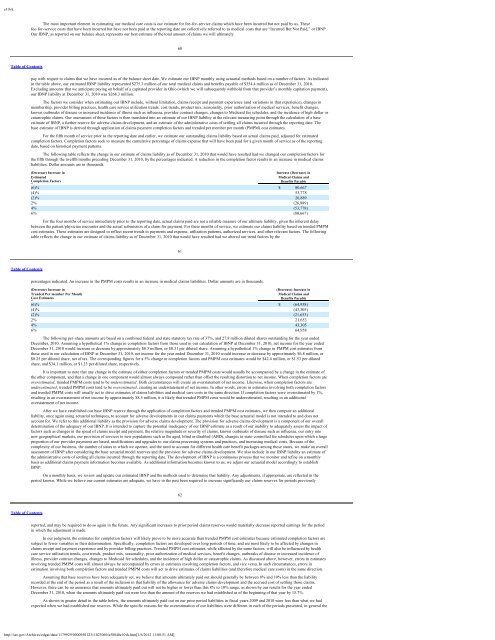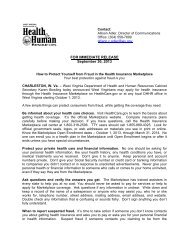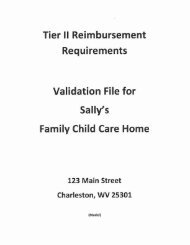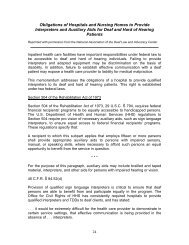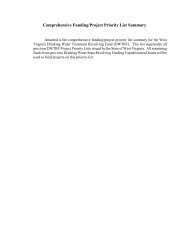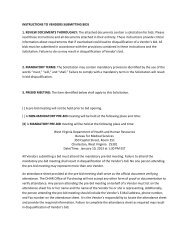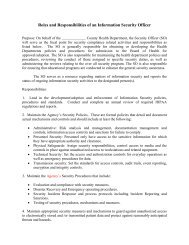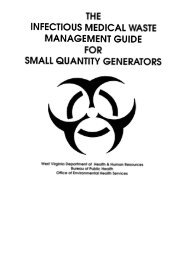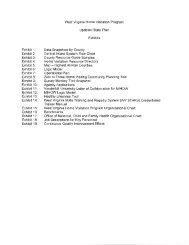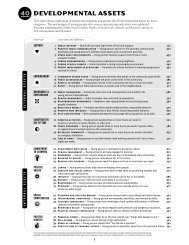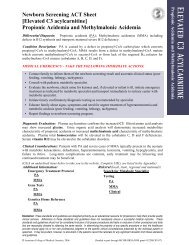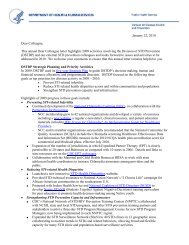Molina Medicaid Solutions - DHHR
Molina Medicaid Solutions - DHHR
Molina Medicaid Solutions - DHHR
You also want an ePaper? Increase the reach of your titles
YUMPU automatically turns print PDFs into web optimized ePapers that Google loves.
e10vkThe most important element in estimating our medical care costs is our estimate for fee-for-service claims which have been incurred but not paid by us. Thesefee-for-service costs that have been incurred but have not been paid at the reporting date are collectively referred to as medical costs that are “Incurred But Not Paid,” or IBNP.Our IBNP, as reported on our balance sheet, represents our best estimate of the total amount of claims we will ultimately60Table of Contentspay with respect to claims that we have incurred as of the balance sheet date. We estimate our IBNP monthly using actuarial methods based on a number of factors. As indicatedin the table above, our estimated IBNP liability represented $275.3 million of our total medical claims and benefits payable of $354.4 million as of December 31, 2010.Excluding amounts that we anticipate paying on behalf of a capitated provider in Ohio (which we will subsequently withhold from that provider’s monthly capitation payment),our IBNP liability at December 31, 2010 was $268.3 million.The factors we consider when estimating our IBNP include, without limitation, claims receipt and payment experience (and variations in that experience), changes inmembership, provider billing practices, health care service utilization trends, cost trends, product mix, seasonality, prior authorization of medical services, benefit changes,known outbreaks of disease or increased incidence of illness such as influenza, provider contract changes, changes to <strong>Medicaid</strong> fee schedules, and the incidence of high dollar orcatastrophic claims. Our assessment of these factors is then translated into an estimate of our IBNP liability at the relevant measuring point through the calculation of a baseestimate of IBNP, a further reserve for adverse claims development, and an estimate of the administrative costs of settling all claims incurred through the reporting date. Thebase estimate of IBNP is derived through application of claims payment completion factors and trended per member per month (PMPM) cost estimates.For the fifth month of service prior to the reporting date and earlier, we estimate our outstanding claims liability based on actual claims paid, adjusted for estimatedcompletion factors. Completion factors seek to measure the cumulative percentage of claims expense that will have been paid for a given month of service as of the reportingdate, based on historical payment patterns.The following table reflects the change in our estimate of claims liability as of December 31, 2010 that would have resulted had we changed our completion factors forthe fifth through the twelfth months preceding December 31, 2010, by the percentages indicated. A reduction in the completion factor results in an increase in medical claimsliabilities. Dollar amounts are in thousands.(Decrease) Increase inIncrease (Decrease) inEstimated Medical Claims andCompletion Factors Benefits Payable(6)% $ 80,667(4)% 53,778(2)% 26,8892% (26,889)4% (53,778)6% (80,667)For the four months of service immediately prior to the reporting date, actual claims paid are not a reliable measure of our ultimate liability, given the inherent delaybetween the patient/physician encounter and the actual submission of a claim for payment. For these months of service, we estimate our claims liability based on trended PMPMcost estimates. These estimates are designed to reflect recent trends in payments and expense, utilization patterns, authorized services, and other relevant factors. The followingtable reflects the change in our estimate of claims liability as of December 31, 2010 that would have resulted had we altered our trend factors by the61Table of Contentspercentages indicated. An increase in the PMPM costs results in an increase in medical claims liabilities. Dollar amounts are in thousands.(Decrease) Increase in(Decrease) Increase inTrended Per member Per MonthMedical Claims andCost Estimates Benefits Payable(6)% $ (64,958)(4)% (43,305)(2)% (21,653)2% 21,6534% 43,3056% 64,958The following per-share amounts are based on a combined federal and state statutory tax rate of 37%, and 27.8 million diluted shares outstanding for the year endedDecember, 2010. Assuming a hypothetical 1% change in completion factors from those used in our calculation of IBNP at December 31, 2010, net income for the year endedDecember 31, 2010 would increase or decrease by approximately $8.5 million, or $0.31 per diluted share. Assuming a hypothetical 1% change in PMPM cost estimates fromthose used in our calculation of IBNP at December 31, 2010, net income for the year ended December 31, 2010 would increase or decrease by approximately $6.8 million, or$0.25 per diluted share, net of tax. The corresponding figures for a 5% change in completion factors and PMPM cost estimates would be $42.4 million, or $1.53 per dilutedshare, and $34.1 million, or $1.23 per diluted share, respectively.It is important to note that any change in the estimate of either completion factors or trended PMPM costs would usually be accompanied by a change in the estimate ofthe other component, and that a change in one component would almost always compound rather than offset the resulting distortion to net income. When completion factors areoverestimated, trended PMPM costs tend to be underestimated. Both circumstances will create an overstatement of net income. Likewise, when completion factors areunderestimated, trended PMPM costs tend to be overestimated, creating an understatement of net income. In other words, errors in estimates involving both completion factorsand trended PMPM costs will usually act to drive estimates of claims liabilities and medical care costs in the same direction. If completion factors were overestimated by 1%,resulting in an overstatement of net income by approximately $8.5 million, it is likely that trended PMPM costs would be underestimated, resulting in an additionaloverstatement of net income.After we have established our base IBNP reserve through the application of completion factors and trended PMPM cost estimates, we then compute an additionalliability, once again using actuarial techniques, to account for adverse developments in our claims payments which the base actuarial model is not intended to and does notaccount for. We refer to this additional liability as the provision for adverse claims development. The provision for adverse claims development is a component of our overalldetermination of the adequacy of our IBNP. It is intended to capture the potential inadequacy of our IBNP estimate as a result of our inability to adequately assess the impact offactors such as changes in the speed of claims receipt and payment, the relative magnitude or severity of claims, known outbreaks of disease such as influenza, our entry intonew geographical markets, our provision of services to new populations such as the aged, blind or disabled (ABD), changes to state-controlled fee schedules upon which a largeproportion of our provider payments are based, modifications and upgrades to our claims processing systems and practices, and increasing medical costs. Because of thecomplexity of our business, the number of states in which we operate, and the need to account for different health care benefit packages among those states, we make an overallassessment of IBNP after considering the base actuarial model reserves and the provision for adverse claims development. We also include in our IBNP liability an estimate ofthe administrative costs of settling all claims incurred through the reporting date. The development of IBNP is a continuous process that we monitor and refine on a monthlybasis as additional claims payment information becomes available. As additional information becomes known to us, we adjust our actuarial model accordingly to establishIBNP.On a monthly basis, we review and update our estimated IBNP and the methods used to determine that liability. Any adjustments, if appropriate, are reflected in theperiod known. While we believe our current estimates are adequate, we have in the past been required to increase significantly our claims reserves for periods previously62Table of Contentsreported, and may be required to do so again in the future. Any significant increases to prior period claims reserves would materially decrease reported earnings for the periodin which the adjustment is made.In our judgment, the estimates for completion factors will likely prove to be more accurate than trended PMPM cost estimates because estimated completion factors aresubject to fewer variables in their determination. Specifically, completion factors are developed over long periods of time, and are most likely to be affected by changes inclaims receipt and payment experience and by provider billing practices. Trended PMPM cost estimates, while affected by the same factors, will also be influenced by healthcare service utilization trends, cost trends, product mix, seasonality, prior authorization of medical services, benefit changes, outbreaks of disease or increased incidence ofillness, provider contract changes, changes to <strong>Medicaid</strong> fee schedules, and the incidence of high dollar or catastrophic claims. As discussed above, however, errors in estimatesinvolving trended PMPM costs will almost always be accompanied by errors in estimates involving completion factors, and vice versa. In such circumstances, errors inestimation involving both completion factors and trended PMPM costs will act to drive estimates of claims liabilities (and therefore medical care costs) in the same direction.Assuming that base reserves have been adequately set, we believe that amounts ultimately paid out should generally be between 8% and 10% less than the liabilityrecorded at the end of the period as a result of the inclusion in that liability of the allowance for adverse claims development and the accrued cost of settling those claims.However, there can be no assurance that amounts ultimately paid out will not be higher or lower than this 8% to 10% range, as shown by our results for the year endedDecember 31, 2010, when the amounts ultimately paid out were less than the amount of the reserves we had established as of the beginning of that year by 15.7%.As shown in greater detail in the table below, the amounts ultimately paid out on our prior period liabilities in fiscal years 2009 and 2010 were less than what we hadexpected when we had established our reserves. While the specific reasons for the overestimation of our liabilities were different in each of the periods presented, in general thehttp://sec.gov/Archives/edgar/data/1179929/000095012311023069/a58840e10vk.htm[1/6/2012 11:08:51 AM]


